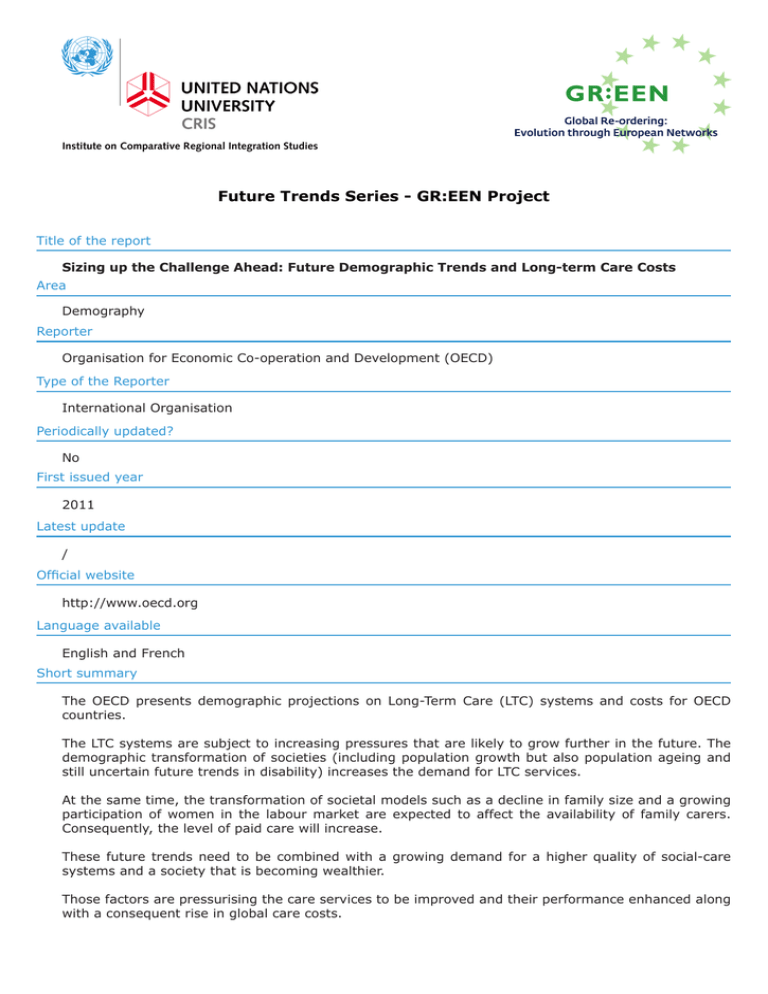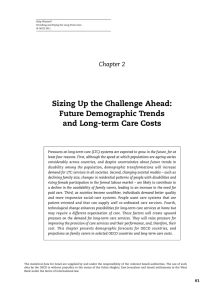Future Trends Series - GR:EEN Project
advertisement

Future Trends Series - GR:EEN Project Title of the report Sizing up the Challenge Ahead: Future Demographic Trends and Long-term Care Costs Area Demography Reporter Organisation for Economic Co-operation and Development (OECD) Type of the Reporter International Organisation Periodically updated? No First issued year 2011 Latest update / Official website http://www.oecd.org Language available English and French Short summary The OECD presents demographic projections on Long-Term Care (LTC) systems and costs for OECD countries. The LTC systems are subject to increasing pressures that are likely to grow further in the future. The demographic transformation of societies (including population growth but also population ageing and still uncertain future trends in disability) increases the demand for LTC services. At the same time, the transformation of societal models such as a decline in family size and a growing participation of women in the labour market are expected to affect the availability of family carers. Consequently, the level of paid care will increase. These future trends need to be combined with a growing demand for a higher quality of social-care systems and a society that is becoming wealthier. Those factors are pressurising the care services to be improved and their performance enhanced along with a consequent rise in global care costs. Key trends • By 2050, the demand for LTC workers is expected to at least double. • The availability of family care is expected to decline causing the rise in LTC spending to exacerbate. • Trends on severe disability among elderly people do not show a consistent decline in disability in all OECD countries. • The future gains in productivity could compensate the future increase of LTC costs. • “For the eleven OECD countries for which information is available, the total number of full-time equivalent nurses and personal carers working in the LTC sector currently ranges between 1 and 2 per cent of the total workforce, on average. For many countries, this share could more than double by 2050 […]. This reflects the expected rise in the number of dependents requiring formal care (demand for care).” Increasing demands related to LTC combined with declining labour supply could put pressure on wages in the LTC sector. • “The private portion of LTC expenditure as a share of GDP can be expected to move in line with the public portion of LTC expenditure, i.e., to at least double and possibly triple by 2050. For those countries which report some information on private LTC spending in OECD Health Data, the private share of LTC expenditure generally falls between 0.1 and 0.4 per cent of GDP in 2006 (with the exception of Switzerland with a share above 1 per cent of GDP)”. Modifying the mixed public/private financing of LTC services has large consequences for budgets of users. Mixing public and private finance has a strong incidence on how much individuals have to pay for LTC services and have therefore major implications on their ability to pay for LTC services. Suggestions • Policies supporting carers should be developed as the availability of family carers is expected to decline. The analysis suggests that either a higher part of the population will need to commit to unpaid care over time; or those involved in unpaid care will be pressured to increase their duties as carers; or pressure will increase to shift to the formal sector. • The rise by 2050 of formal LTC use and expenditure implies that policies should support improvement of recruitment, retention and productivity of LTC workers. • Both formal and family care arrangements should be addressed in future policies as recruiting LTC workers in the future will be a greater challenge and will likely exacerbate future pressure on wages. • Healthy ageing policies would help mitigating growth in long-term care spending, but also increase the size of the family carers supply and the labour force. Methodology Modelling and research from secondary sources Reference to other trends reports? If yes, which reports? - OECD, Projecting OECD Health and Long-term Care Expenditures: What are the Main Drivers?, OECD Economics Department Working Paper, No. 477, OECD Publishing, Paris, 2006. - Swedish Ministry of Health and Social Affairs, The Future Need for Care. Results from the LEV Project, Government Offices of Sweden, September 2010. - R. Wittenberd et al., Future Demand for Social Care, 2005 to 2041: Projections of Demand for Social Care for Older People in England, Report to the Strategy Unit (Cabinet Office) and the Department of Health, Personal Social Services Research Unit, Discussion Paper, No. 2514, London, 2008.



